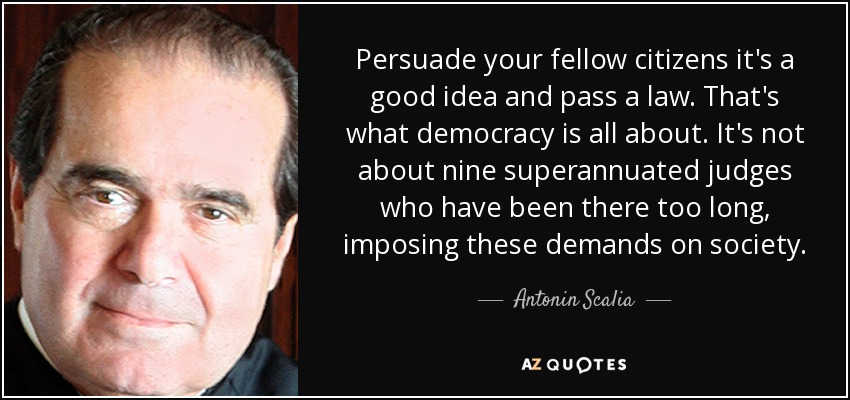
What happens to this Term’s close cases?
The passing of Justice Scalia of course affects the cases now before the Court. Votes that the Justice cast in cases that have not been publicly decided are void. Of course, if Justice Scalia’s vote was not necessary to the outcome – for example, if he was in the dissent or if the majority included more than five Justices – then the case will still be decided, only by an eight-member Court.
If Justice Scalia was part of a five-Justice majority in a case – for example, the Friedrichs case, in which the Court was expected to limit mandatory union contributions – the Court is now divided four to four. In those cases, there is no majority for a decision and the lower court’s ruling stands, as if the Supreme Court had never heard the case. Because it is very unlikely that a replacement will be appointed this Term, we should expect to see a number of such cases in which the lower court’s decision is “affirmed by an equally divided Court.”
The most immediate and important implications involve that union case and Fisher v. University of Texas at Austin, in which the Court was expected to limit affirmative action in public higher education. Conservative rulings in those cases are now unlikely to issue. Other significant cases in which the Court may now be equally divided include Evenwel v. Abbott (on the meaning of the “one person, one vote” guarantee), the cases challenging the accommodation for religious organizations under the Affordable Care Act’s contraceptive mandate, and the challenge to the Obama administration’s immigration policy.
The Court is also of course hearing a significant abortion case, involving multiple restrictions adopted by Texas. In my estimation, the Court was likely to strike those provisions down. If so, the Court would still rule – deciding the case with eight Justices.
There is also recent precedent for the Court to attempt to avoid issuing a number of equally divided rulings. In Chief Justice Roberts’s first Term, the Court in similar circumstances decided a number of significant cases by instead issuing relatively unimportant, often procedural decisions. It is unclear if the Justices will take the same approach in any of this Term’s major, closely divided cases.What happens to this Term’s close cases? : SCOTUSblog:
First reactions on the passing of Justice Scalia
The first and most important reaction is to extend our sympathies to Justice Scalia’s wife, Maureen, and his entire family, including his nine children and numerous grandchildren. The Justice is a historic figure, surely one of the most influential legal minds – on and off the Court – of the last century. His contributions to the law are incalculable. They substantially reframed discussions of constitutional, statutory, and administrative law.
The most immediate implications involve the presidential election. President Obama of course has the power to nominate a successor, with the consent of the Senate. In the ordinary course, because the opening was unexpected, the nomination would not be forthcoming for a couple of months and then the confirmation process would take several more months.
Theoretically, that process could conclude before the November election. But realistically, it cannot absent essentially a consensus nominee – and probably not even then, given the stakes. A Democratic president would replace a leading conservative vote on a closely divided Court. The Republican Senate will not permit such a consequential nomination – which would radically shift the balance of ideological power on the Court – to go forward.
There is the related question of the Court becoming an issue in the election. Before today, it was unlikely that many voters would choose a presidential candidate for this reason, given the importance of issues like the economy, terrorism, and immigration. But the fact that there is an immediate vacancy – and a vacancy that could tip the Court’s ideological balance – makes the future of the Court much more concrete.
In the political primaries, the Court is not an issue that divides candidates of the same party. Both Hillary Clinton and Bernie Sanders, for example, are clear that they would want to appoint a more liberal successor that would oppose decisions like the Citizens United campaign finance ruling. The leading Republican candidates would all make clear their support for a nominee who would oppose the Court’s rulings upholding the Affordable Care Act.
In the general election, the Court is also an issue that tends to drive the base of each party, so it may be most relevant to turn-out rather than to changing voters’ minds. In general terms, conservatives have been more focused than progressives on the Court as a presidential legacy. But both parties have groups of voters – on the left, supporting abortion rights, and on the right, supporting gun rights and opposing abortion, for example – for which the Court has outsized importance.
